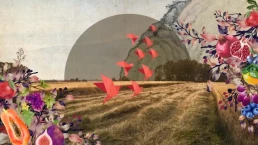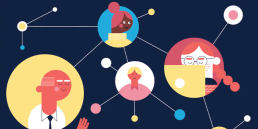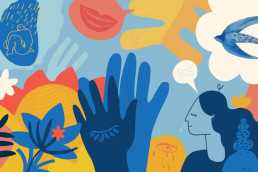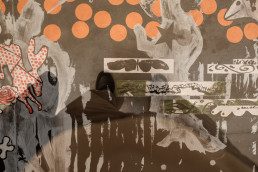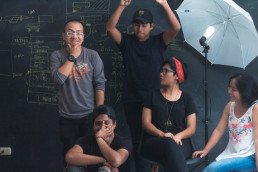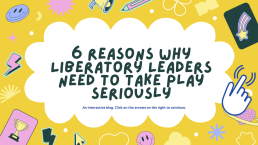What happened when we made space for harvest
January 24, 2023Self Care,Reflection and Learning,TransformationBlog,Self Care,Reflection
As the pandemic(s) continue, and in the midst of the great resignation, global unrest, and the unfolding of the anthropocene, we are still here. Like so many of you, we are still working. Still worldbuilding.
And like so many of you, we’ve been doing this work alongside colleagues we haven’t hugged in years. Some of whom we’ve never even met in real life.
We’re doing our best to build connection and humanity through Zoom screens, phone calls, emails, and DMs. All the while, doing our best to support one another through the urgencies of life — elder care, child care, health emergencies, grief, and loss. And celebrating the beautiful moments too — life milestones, celebrations, small and big joys.
Last fall, our team members called for a season of harvest. An intentional period of reflection and beingness — being with one another and what we’ve learned over these last two years.
We knew that these learnings did not just exist in Google docs, meeting notes, and post-event surveys. What we’ve learned also lives in our bodies and in our collective memory. And needed space, time, and intention to surface.
And so we did. Our team set a number of objectives for this harvest: investing in the interpersonal relationships on our team with spaciousness and care; taking in the worldbuilding lessons and impacts we’ve been experiencing in our selves, communities, and systems; and in this process, building out a map of what is next for Resonance.
We have surfaced so much already — and the learnings are still coming, but these three are the most vivid in this moment:
1. Being with what’s real (instead of just pushing through)
In the fall of 2022, we began planning an in-person team gathering for October. After two years of being unable to be together in person, we painstakingly chose a location based on our team members’ care needs and travel abilities. We discussed COVID protocols and settled on a time, place, and flow that felt right to everyone. Several team members took the lead on developing an agenda that prioritized ease, joy, and togetherness–and also planning and visioning for the new year. (The kind of work that happens best in 3-D, with access to post-its and art supplies, dry erase boards and tea.)
We were so eager to gather.
Then, less than two weeks before our departure date, two of our team members had family medical emergencies. Caretaking responsibilities would likely prevent them from traveling. The agenda team re-convened. We adjusted the flow of activities, and with the consent of our team members, we decided to move ahead with gathering. Then another team member had a family emergency.
We adjusted once again, wanting to remain in the energy of what was possible. We explored ways to weave in team members as they were able. But one by one, life intervened until, days before we were meant to depart, only 3 of us were able to attend in person. And it became clear it was time to shift course.
And just like that, we found ourselves back on a Zoom screen. In some ways, the mutedness of online space felt even harder after the prospect of in-person connection.
But this whole experience was a vivid lesson in being with what is real. Every step of the way, we adjusted to meet ourselves where we were, and to be with what was possible in each moment. In the end, that meant shifting our plan entirely. And we were holding disappointment and grief at not being able to gather — but we also still had work to do.
And in the ensuing weeks and months, that work has taken shape — in small groups, and in a different flow than we’d planned, but it’s happening. Much of it online. Some of our team members are close enough to gather in person, so that happens sometimes too. We’re meeting each other where we are, and finding flow where we can.
2. Working with the seasons
Last year, the Resonance team embraced a rhythm of work and rest that parallelled the flow of the natural world. A way of being, once again, with what is real — the energy of the seasons — rather than the notions of capitalist production that invite us to sacrifice our wellness and connection for our work.
Above all, we remain committed to our individual and collective wholeness.
We know that rest is necessary to be in integrity with ourselves–and the world we’re building. And there just isn’t space for rest in the dominant worldview. But there’s something that feels right about taking a cue from the seasons.
Our bodies are already a part of nature; we are already feeling the energy shifts of the seasons. This has simply been a practice of honoring that. And what we’ve been reminded of in this practice is that — there are different kinds of work. And being in the flow of the seasons makes space for all of them.
The spring was bright and full of energy, activity, and programming. There was a buzz to that time that began to ease slightly into the summer and fall. And now, as the days shorten and winter draws in, it feels right to be slowing down. The earth (in the Northern Hemisphere where most of us are) is supporting us in that.
Colonial capitalism tells us that production is the only kind of work that matters. We know that’s not true. And giving ourselves space to feel into the other kinds has been a gift. This fall and winter has met us in a depth of reflection — individually and together — and investing time and care in relationship.
Trusting that we have everything we need is a practice of being with what we have, what is here — and trusting in the wisdom that lives in the moment, and everything that conspired to bring us to it.
Being in our harvest period this fall…felt right. Fall is a season of harvest. And our team was able to be together (albeit virtually), and harvest from the richness we’ve cultivated together over the last two years. (Metaphorically) making jam. And being in community.
This is a part of the work that requires space and intention. And will enrich what comes next.
3. We have everything we need
Our beloved co-director, Alexis Flanagan said these words on a staff call a few weeks ago, and they were met with silence as we all took a moment to receive them. In full transparency, this is a lesson not that we’ve learned, but rather one that we are learning and leaning into, individually and together.
Trusting that we have everything we need is a practice of being with what we have, what is here — and trusting in the wisdom that lives in the moment, and everything that conspired to bring us to it. It is a practice of looking within, rather than seeking ‘more’ outside of ourselves.
In a culture that says we can never have enough, trusting that we have what we need is a bold transforming of the scarcity and lack in capitalism and white supremacy.
It is a practice of trusting that we are enough.
At the end of the day, what else do we have but ourselves and each other?
We are enough.
What would it feel like to trust that you have everything you need?
originally published at The Reverb
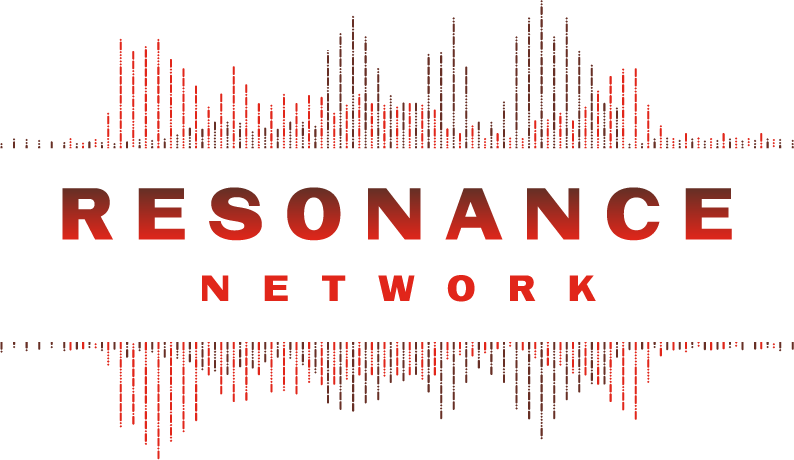
Resonance Network is a national network of people building a world beyond violence.

Network Weaver is dedicated to offering free content to all – in support of equity, justice and transformation for all.
We appreciate your support!
donate in the box above or click here
Turning the stone: embedding systems thinking in the everyday
January 12, 2023Transformation,BlogSystems Change,Systems Change
The context
Images
Isn’t it interesting how frequently as human beings we turn to metaphor? Sometimes these images are so embedded in the everyday that we don’t see them for what they are. We talk about ‘just ploughing on’, ‘turning over a new leaf’ and much more. Why? Because we don’t feel, think and communicate solely in mechanistic term, we are not ‘desiccated calculating machines’. We think in patterns, through resonance, emotion, stories and intuitive connection as well as logic.
Metaphor evokes in us things the literal cannot. It uses the poet’s deftness to reduce the messiness of the world, rejects the technocrat’s straight line sketch of reality. Metaphors also offer shortcuts to submerged mental models or situations, containing in their DNA bundles of previous inter-related experience and learning. I find images can be useful touchstones or motifs around which to organise my thoughts or re-centre activity or purpose. ‘Be more water’ etc.

Systems
Given this, it’s not surprising that imagery and metaphor feature heavily in systems thinking.
Over the past six months I’ve been learning about systems thinking approaches as well as systems change — their practical application in the cause of social justice or similar ends. I’ve been exposed to an intoxicating array of philosophies, tools, narratives and claims. Inevitably some have resonated more strongly than others. A couple I have found a bit vague (but probably didn’t understand) and a couple I have found a bit opaque (and definitely didn’t understand).
But the process of learning has been quite liberating. It has given me new ways to think about the universe I exist within; who can ask for more than that?
Imagine if a toolkit existed which allowed you to pick the lock of whatever complex policy or operational challenges you were dealing with that day. But also somehow captured the shifting beauty of a thousand starlings in flight or the majesty of the moss covered forest-as-organism. Something that gave definition and structure to all the intuitive system-craft we develop simply by being tenacious and creative in our work. That to me is the appeal of systems thinking.
Systems change in the everyday
Some of the approaches I have come to know take hard work, safeguarded time and the willing collaboration of colleagues. Others flit around at the paradigm level, triggering unconscious mindset micro-recalibrations. The variety is at times overwhelming.
So when I asked myself what artefact I wanted to produce to mark the end of my School of System Change Basecamp programme I thought I would consider practical ways to weave embed systemic practice into the everyday.
After reflection I concluded first one thing and then another. Firstly, that identifying and developing the mental and behavioural pre-conditions which allow systemic thinking to flourish is probably more important than striving to develop deep technical understanding of specific tools — after all no plants will grow in a barren field, no matter how packed with potential the seed. And secondly that I wanted to use emblematic metaphors to pin down the most important of these core attitudes, from which a number of simple, everyday systemic practices could then flow.
So the three sections below are a simple — and imperfect — attempt at that. Three images to lodge in my head, and perhaps yours too.
The images

Turning the stone
I have a memory as a child of turning a large flat stone in a wood and becoming enthralled at the universe-in-miniature beneath it. Insect life, leaf mulch, moss. The dynamic equilibrium of decay and fertility, death and life.
Although it’s impossible to pin down what systems thinking/change represents to any single person, for me it is a world-view build on a deep curiosity about the universe and our place in it. It’s hard to be open to other standpoints, learn or develop without an open mind (and an open heart too). A sense of ongoing intellectual and social inquiry can turbo-change any job which requires tactical relationship building, political weather reading, policy landscape navigating and hard decision making.
Ways to turn the stone:
- Deliberately immerse yourself in media and news sources you know you’ll disagree with. Take time to mentally articulate why you disagree with the arguments and be wary of jumping to conclusions. This is actually quite hard to do! The voluntary sector in the UK, for instance, has an obvious bias towards the soft left politically but I hear few people challenging the system to actively seek out opposing views and force the remaking of arguments for the full range of world-views. If you find your ideas shored up by the process that’s great — like a vital aircraft component that’s been stress-tested to near destruction in the workshop it is now ready for use in the outside world. However you may find your ideas slowly changing — it’s all part of ‘exposing your mental models to the light of day’ (Donella Meadows). [ap_spacing spacing_height="5px"]
- ‘Get the beat of the system’ (DM again) — set up a rolling meeting with an inter-disciplinary cast representing the most obvious system viewpoints around which you are working. Or convene a space with four or five experts from the same discipline. Get a monthly Zoom/Team invite in the diary and the admin load is light. Help set the tone and model behaviour at the beginning then sit back — see what people bring. It’s amazing the insights, thoughts, ideas (and yes rants) people share, once they are convinced of the fact they are within a group of trusted system colleagues, outside the more formal spaces of government forums and rigid agendas. Sometimes this more explorative space may feel unfamiliar so you may need to sell it as an informal advisory group of some kind. Convening isn’t about just ‘doing the admin’ it’s about setting a tone, making people feel valued and respected, ‘holding the space’ and modelling behaviour that you wish to see others exhibit.

Building the spider’s web
There are three basic elements in any system — data points (people, perspectives, organisations, cells, trees), the connections between them and a uniting, animating purpose. My observation from policy work is that too much attention is paid to the things themselves and not enough to the connections between them.
Building a network of contacts — and entrepreneurially convening flexible spaces within it — may again allow you to get the beat of the system and develop a more richly detailed (though still partial) map of the territory. A fancy name for this might be ‘distributed cognition’, but I think of it as building a web.
Ways to build the web:
- At the most simple level it could be consciously focusing on the relational. Almost all roles and ways of exploring the world involve working with and through others so relationships are obviously key. Systems leadership across organisational boundaries is impossible without high-quality, sticky and trusting relationships. These will support all future work from developing shared campaign positions to negotiating the finances of a major joint operational undertaking. Thinking of relational work as the work and not just a means to doing the work might help.[ap_spacing spacing_height="5px"]
- If getting into systems change feels a bit like joining a secret society then it follows that you must identify and cultivate your fellow travellers. They will not appear according to rank, status or job description. Some will be formally trained and others not. Carving out space and time is key here, which is why I’ve started some thinking about a systems change learning club with an emphasis on the fun, informal side of systems exploration.

Looking into the pond
Knowledge of self precedes almost all other forms of knowledge. The wisdom of the ages tells us that we must know ourselves before turning to identify problems and solutions in the external world — ‘physician, heal thyself’.
There is no two ways about it — to work systemically is to work reflectively. The whole idea is about taking a step back and what is that other than an instruction for reflection?
The image of a still pond reveals itself to me here. Mirror-like, but not a mirror. A surface broken by debris, imperfectly reflecting a face.
Ways to look into the pond:
- Building simple reflective practice into the everyday. Do you have a key series of meetings or a super important stakeholder relationships to develop? Or perhaps a colleague you are struggling to get on with? Or a knotty policy issue dancing before your eyes? Try journaling. Don’t overthink it, use a physical journal or a note-taking app like Evernote to get some stuff down. This is usually about the wisdom of the moment so try to do it immediately after the event rather than in hindsight (when our brains begin to impose post-hoc rationalisation). I remember doing this after my first board meeting and breaking it into ‘head’ and ‘heart’. The first covered the mental and bodily experience of a potentially stressful situation, the second provides analytic commentary on how events unfolded and how things could be different next time.[ap_spacing spacing_height="5px"]
- The pond does not reflect just the individual but the system itself. One of the School for System Change’s systemic practices — which I love — is ‘enabling the system to see itself, hold the whole picture’. Think about the causal chains that (nominally at least) link the key data points within the system you are working on. For me it might be something like: minister is keen on a policy, directs senior officials; officials develop policy framework; resource devolved to local government level; commissioner commissions provider; provider CEO sets out a vision; ops director mobilises a service; practitioners make the magic happen for people in recovery; person in recovery volunteers as peer mentor. (You can make it more or less detailed as you see fit.) Now typically most data points (people in this instance) are familiar with only their neighbouring one or two points but much less so with the ones further up or down ‘the food chain’. Short-circuiting those connections can have powerful results. I recently organised a trip for a very senior civil servant who had taken on the treatment and recovery brief. We brought him, and other officials, to a recovery service in North London to listen and learn from senior public health representatives, local government commissioners, frontline workers and people in recovery. And in that room in Tottenham the system was presented with a mirror and — fleetingly — could see itself and understand its shared purpose. The officials walked away remembering that policy-making is not an end in itself but an embodiment of the social contract in action; communal resource being deployed to high quality create public services. The frontline workers walked away feeling that policymaking at the centre is hard, but has good people attempting to address that hardness. Things click into place. ‘Ah, I get why that join up with criminal justice doesn’t work properly, as you’ve had your budgets hammered’. ‘So that’s what assertive outreach is, I had always wondered’. ‘So which agencies should we try and bring together at a local level to provide accountability back to the centre?’ ‘I can see it now, this is why we do what we do — communities improved, families healed, citizens recovering connection and meaning’.[ap_spacing spacing_height="5px"]
- Finally I hope the pond will reveal the embedded nature of our locations within multiple overlapping systems. And the see-sawing of feelings this realisation brings — greater understanding, identification of allies and experience of positive change delivering hope and a potent sense of agency on the one hand, awe at the scale and intricacies of the systems which shape the problems we wrestle with delivering a sense of hopelessness on the other. It might be daunting but we are part of it. As one of my co-learners brilliantly put it: ‘I am the system; we are the system’.
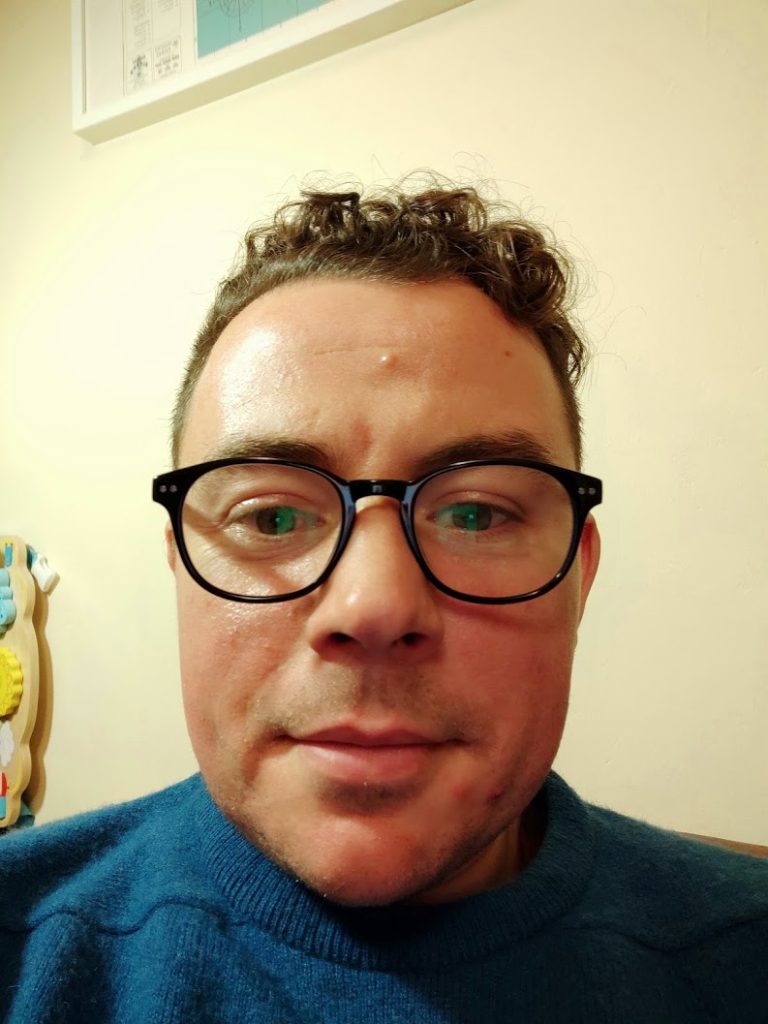
Oliver Standing is Director of Collective Voice, the national alliance of drug and alcohol treatment and recovery charities. He is responsible for its day to day leadership and delivery of its main activity – policy and advocacy work to help bring about an effective, evidence-based and person-centred support system for anyone in England with a drug or alcohol problem. Collective Voice also shares good practice and brings together networks across the sector.
Before this Oliver worked for Adfam (the national charity working to improve support for families affected by drug or alcohol use) for eight years, latterly as Director of Policy and Communications. He has a deep interest in systems change, having taken part in the School for Systems Change Basecamp for Health Leaders in 2021, with a particular focus on policy-making in complex environments and driving collaboration across organisational boundaries. https://twitter.com/OliverStanding
originally published at School of Systems Change

Network Weaver is dedicated to offering free content to all – in support of equity, justice and transformation for all.
We appreciate your support!
donate in the box above or click here
Understanding network strategy
January 10, 2023Network Structure and Governance,Network Processes,Blognetworks,NetworkStrategy
Every organization needs an effective strategy. Strategy can refer to an overarching strategic plan at the organizational level or a strategy towards achieving specific organizational needs and goals. A strategy will set the way forward for an organization in alignment with its overarching vision and mission. It will articulate the priorities and directions the organization should take as well as convey the “what”, “why”, and “how” to accomplish its goals, often within a given period, by clearly defining the pathways towards achieving them.
At Collective Mind, we’ve learned a number of lessons through our work with networks developing strategies and strategic plans.
Context matters
Strategy for networks is different than strategy for more traditional organizational models. Networks are a unique type of organization with a complex operating model. They are different in how they’re organized, who’s involved, and how they get things done.
First, networks are horizontal, flat structures: they are not top-down, hierarchical, or directive. They are loosely controlled, with multiple mechanisms for collaboration and without any mechanisms for command and control.
Second, networks are comprised of members — without members, you don’t have a network — and the complexity of that membership typically matches the complexity of the network’s issue area. As such, the network must meaningfully integrate a wide diversity of people and/or organizations in an equitable fashion. It must be flexible and agile enough to capture the emergence that arises from such diversity and the interconnections across it.
Finally, because of these characteristics, networks operate differently. They seek to harness the collective intelligence within them, dispersing leadership and sharing decision-making. They typically don’t procure deliverables but focus on stimulating activities by their members, who are responsible for creating the outputs of the network. This relationship between members and the network is typically voluntary and about creating shared value, not premised on a contractual relationship. Consequently, the network’s staff (if there is a staff) aims to support its members by helping facilitate the production of outputs, rather than directly implementing and delivering those themselves.
How networks are different influences strategy
Within this unique and complex operating environment of networks, we can consider strategy differently in at least three ways: process, content, and implementation.
Process: we must ensure that the process to develop the strategy or strategic plan empowers members and any other stakeholders and establishes their ownership of it. This requires a participatory, inclusive process with mixed methods for inclusive, meaningful participation. An iterative and adaptive process should build from one step to the next toward the final strategy. The steps of the process should ensure ongoing triangulation and validation of key ideas, needs, priorities, and pathways with stakeholders as they are developed.
Content: we must ensure that the strategy or strategic plan represents a collective effort. It should set collective priorities and determine the collaborative paths to achieve them by facilitating consensus-building throughout the process. The plan’s priorities and goals should be grounded in the needs, interests, and capacities of the membership. The substance of the plan must reflect the goals, expectations, and motivations of the members.
Implementation: we must clarify and define who will implement the strategy. As explained above, in the context of a network, it must be its members that produce the outputs with support from the network staff. We must clarify how this can be done realistically and right-size the strategy to ensure the feasibility of that implementation (for example, recognizing the limitations on members’ capacity, time, etc.). We must ensure that the plan supports the network to align energy, resources, and stakeholders for collective impact.
A clear and effective strategy will define in what direction the network and its membership will move forward. It will reflect and align with the needs and interests of its members, defining initiatives and activities through which members can participate and collaborate. Consequently, it will clearly articulate the unique added value that the network as a collective can create that is greater than the sum of those parts.
Interested to hear more about how we approach strategy development with networks and how we can support you? Contact Kerstin Tebbe at kerstin@collectivemindglobal.org.

Kerstin Tebbe has almost 20 years of experience supporting networks and multi-stakeholder collaboration. Kerstin founded Collective Mind in late 2019 after many years of independent study and research on networks. With Collective Mind, she has supported networks from local to global on a wide range of challenges. Kerstin has lived and worked in New York, Buenos Aires, Paris, Nairobi, Geneva, and Washington DC. When she’s not thinking about networks, she’s dancing.
originally published at Collective Mind
Illustration by Patrick Hruby, found HERE

Network Weaver is dedicated to offering free content to all – in support of equity, justice and transformation for all.
We appreciate your support!
donate in the box above or click here
Decentralized organizing: More collaboration, less hierarchy
January 3, 2023Transformation,Blog,Systems ChangeGovernance,Systems Change
From organisational governance to mobilising and sustaining grassroots movements, what is decentralised organising and how can this approach facilitate collective but efficient decision-making without management hierarchy?
Decentralised organising isn’t just about delegating tasks and responsibilities. It’s about transparency and openness, including how financial decisions are made and how labour is divided. This approach creates a great work ethic:
- Empowering members to do the work they care about, not just what they’re told to do
- Cultivating a culture of trust, collaboration and transparency
- Incentives are aligned because ownership is open to all
Sounds good? We recently caught up with Rich and Nati from Loomio while they were in London and discussed some useful decentralised organising approaches. Here are some changes you can easily implement to start working more collaboratively with less hierarchy:
Establishing “ground rules”
Norms are informal agreements about how group members should behave and work together, e.g. open, honest, inclusive. Boundaries are behaviours that we want to exclude, e.g. no mean feedback, exclusionary decision-making. Collectively, norms and boundaries can also be referred to “ground rules”.
Take time to listen to each member’s perspective. Then, as a group, decide on what your shared norms and boundaries will be. Finally, have this documented and accessible to all members and new members so that expectations are clear and transparent. This way everyone is bound by the same ground rules.
Communication norms
Open but efficient communication is a cornerstone of successful and strong relationships. It can be built by establishing communication norms and collectively agreeing on what communication tools to use for what job. For example:
- Realtime: like whatsapp chat: Informal and quick, it’s about right now.
- Asynchronous: Email or Loomio. More formal, organised around topic. Has a subject + context + invitation. Can take days or weeks.
- Static: Google Docs, Staff handbook, or FAQ. Very formal, usually with an explicit process for updating content
An understanding of when to use different communication tools avoids clogging up communication channels with unnecessary information. Finally, it is important to support members to learn how to use tools and remind each other gently to build habit.
Sharing is caring
Hierarchy habits such as having the same chair for team meetings can discourage other members to feel that they can bring ideas forward, participate in decision making, and take leadership. It is important to be intentional about the behaviours you want to bring to your organisation or network so that members trust each other and feel comfortable working together:
- Intentionally produce a culture of trust and belonging by sharing power, enabling lots of time for discussion, for natural leaders to be reminded to hold back and let others talk,
- Growing collaboration skills with practice through empathy, reflection and communication. It helps to have 5 mins reflection at the end of the meeting to ask people how they think it went – OR send out an anonymous reflection form just after the meeting to see how it performed against the organisational values.
- Distribute ‘care’ labour: make care work visible so that it can be fairly shared – this includes things like organising biscuits to setting the agenda.
Decentralised organising in practice: The Lambeth Portuguese Wellbeing Partnership
In this next section, we feature the Lambeth Portuguese Community Wellbeing Partnership (LPWP), a grassroots community network of over 40 local groups and community members. Bringing together organisations and people from across the health, social, charity and voluntary sectors to listen and work together, the LPWP is an exciting example of working in partnership through decentralised organising to help the Portuguese speaking community live healthier lives and to remove the barriers they face accessing health services. The partnership are keen to work towards adopting a decentralised organising approach and are on a continuous journey to work towards greater transparency and collaboration to create change.
Their successes and impact so far include
- A Breakfast / Homework Club run in conjunction with a Portuguese Café, a local school, educational charities and the NHS.
- A GP surgery and a voluntary sector organisation carrying out joint assessments of frail and vulnerable patients, with the voluntary community liaison officers providing care-coordination and links into social support.
- End of life and Latin American disability charities working together to modify advance care planning templates, empowering those at the end of life to make the decisions that are important to them.
- Culturally relevant patient leaflets, education videos and an NHS ‘Welcome Brochure’ in Portuguese, informing patients of their NHS rights and self-care options.
- A children’s charity working with scientists, to provide children from vulnerable backgrounds experiences working in science in universities.
The LPWP commissioned the Social Change Agency to support developing a strategic and decentralised organisation framework that will ensure that the partnership can play an active role in helping people with multiple long-term conditions live fulfilling lives for longer. It was a great pleasure to meet and interact with some of the organisations and individuals within this partnership, their passion and commitment to working together through values that include inclusivity and trust to improve the wellbeing of Portuguese speakers in Lambeth is truly inspiring!
If you want to focus was on moving towards flatter hierarchies, grassroots decision-making, and letting go of traditional hierarchies, then get in touch to find out how we can help.

The Social Change Agency is an expert team of strategy consultants, campaigners, communicators, and governance geeks. They’ve launched powerful movements, built innovative networks and led groundbreaking campaigns - their expertise spans every aspect of social change.
originally published at The Social Change Agency

Network Weaver is dedicated to offering free content to all – in support of equity, justice and transformation for all.
We appreciate your support!
donate in the box above or click here
Pattern spotting: a core practice for systems change
December 12, 2022Blog,Systems Change
I find pattern spotting deeply satisfying as a practice. It helps me work with complexity rather than trying to simplify it, it reveals rhythms and structures that can support deep change work, it awakens my curiosity and creativity and quietens my rational brain’s constant quest for answers. At best it reminds me how much the world we live in is alive, and brings a 60s wallpaper sort of joy to very challenging work.
In systems change work, the term “pattern” comes up a lot. We refer to “pattern spotting” as a practice that can help understand the dynamics that characterise a complex system. We ask about “patterns of behaviour” and how to explore their deeper causes. We can even define systems change as “the emergence of a new pattern”, as an outcome where the “pattern of a system has changed”.
However, working with budding and seasoned systems practitioners over the last few years has led me to believe that we are not all putting the same thing behind this magic word. My unsatisfactory attempts to translate it into French (I live and work in the South of France) have also shown how much can be conveyed by this one word. If we want to collectively develop this practice as an effective way of understanding and engaging with systems to create change, we might want to delve a bit deeper into the multiple meanings of “pattern”. This article is an attempt to do that by bringing some structure to the way we think about pattern in the context of systems change.
Systems change pattern spotting: from two dimensions to four dimensions
Pattern recognition is a core ability of the human brain, and that of other animals, whereby information received from the environment — through all the senses — enters the short-term memory and is compared with content stored in the long-term memory. Finding similarities between what we experience now and what we have experienced before enables us to process huge amounts of information in an effective way; we do not need to analyse every piece of data because we can rely on patterns to understand what is happening and what is likely to happen next.
Pattern recognition is necessary for understanding language, recognising people we know, enjoying music and art, engaging in logical thinking and reasoning. This ability draws on several different cognitive processes which allow us to engage with the complexity of the world around us. In this article I am not sharing content around these cognitive processes (Wikipedia is a good starting point for this), but rather a way to think about how we use this ability in systems change work.
I am proposing a structure for exploring “pattern” that is based on our understanding of dimensions. This has helped me tease out some subtle differences system change practitioners are referring to when they speak about pattern spotting. As always, the framework I propose here — from two dimensional to four dimensional patterns — is not a description of reality but a way to engage our visual and geometric cognitive capacities when working with complexity.
Starting with 2D
When thinking of patterns we often think in two dimensions — a motif repeating across a flat space, such as a pattern on a wallpaper. As facilitators of change processes, we might also use two-dimensional pattern-spotting in a conversation or workshop setting when we’re looking to cluster ideas, matching like with like. Here although the setting is alive and three dimensional, the way we’re playing with pattern is effectively in a ‘flat’ space as we organise components into clusters of similar content, or along a spectrum with two polarities.
This is a great skill to strengthen when looking at the world: natural forms are brilliant for repeating patterns, and graphic designers generate wonderful visual shapes in wallpaper and typography. Mathematical patterns can also be a way to explore what I’m calling two-dimensional patterns, looking at sequences of numbers and finding the way they’ve been designed. Or exploring geometric patterns and shapes
However, this is just the starting point for recognising patterns in systems.
Moving to 3D
Beyond this two-dimensional focus, we need to layer on the ability to see patterns across scales and contexts, to work with the interconnected and complex nature of the world. We can understand the living world as being fractal, with shapes that repeat across scales like a fern leaf.
adrienne maree brown has a chapter on fractals in her book Emergent Strategy, Shaping Change, Changing Worlds (2017). She invite us to
“Tune into the prevalence of spiral in the universe — the shape in the prints of our fingertips echoes into geological patterns, all the way to the shape of galaxies. Then notice that the planet is full of these fractals — cauliflower, yes, and broccoli, ferns, deltas, veins through our bodies, tributaries, etc. — all of these are echoes of themselves at the smallest and largest scales.” (pp51–52)
So when exploring systems, we look for core patterns that are showing up across scales. We ask questions such as “How is what is going on at a small level in my team, in this organisation, mirroring or reinforcing a problematic characteristic of the wider sector we’re part of?”
This can be trickier than finding 2D patterns because it’s often harder to see polarities or similarities when we broaden the boundaries within which we are inquiring. Things that might feel quite materially different because of scale — user experience of getting on a train, where people coming from all over the city converge in a station and then get filtered onto their respective trains, with ticket barriers etc. and the organisation of the train network at a national level where regional services converge on big cities and often on the capital in a “all roads lead to Rome” pattern [check this example, centralised energy might be another interesting one] — can be understood to have a fractal quality. To see this, we need to practice being able to ‘zoom out’ and look at more complexity, while holding onto a pattern we’ve identified and are familiar with when we ‘zoom in’.
We might also start looking for patterns across different contexts within a given system or challenge. For example, I worked with a team looking at how to foster more collaboration with groups involved with marine conservation and the definition of priority marine conservation zones. After a lot of thinking about barriers to collaboration, as a group we identified a pattern that was showing up across the piece. The government process for engaging diverse local stakeholders around marine conservation issues was essentially extractive: asking for insight that then just got fed into an opaque decision-making process where the local people had no agency. This mirrored the wider relationship to the sea as a whole, equally extractive — people extracting fish, dredging up sand for the construction industry, thinking of the sea as a leisure space — where the sea’s intrinsic agency as a living system was not brought into the equation at all. Identifying this pattern between the wider issue of our relationship with the sea, and the governance culture and process in place around marine conservation, opened up avenues for creative thinking about how to seed positive change.
Exploring 4D
We have looked at two and three-dimensional patterns, and yet when we are doing systems change work we also need to stretch to four dimensions — to include patterns and change over time.
One big difference between wallpaper and patterns in the living world is that the former, despite some psychedelic motifs that might seem to move, are static, whereas the latter are in constant motion, changing over time. This is essentially because they are relational. If we move beyond the wallpaper pattern seen as an image of forms organised in a certain way on a flat surface, to ask ourselves which relational patterns it is involved with, things come alive: crazy 1960s wallpaper consistently make me smile, and consistently make my mother cringe (which then makes me smile!). These are the patterns of systems change — dynamic patterns of behaviour in the world. Donella Meadows shares the importance of looking for these:
“Systems fool us by presenting themselves — or we fool ourselves by seeing the world — as a series of events. […] We are less likely to be surprised if we can see how events accumulate into dynamic patterns of behavior. […] The behaviour of a system over time — its growth, stagnation, decline, oscillation, randomness or evolution. […] When a systems thinker encounters a problem, the first thing he or she does is look for data, time graphs, the history of the system. That’s because long-term behavior provides clues to the underlying system structure. And structure is key to understanding not just what is happening, but why.” (Donella Meadows, Thinking in systems: a primer, 2008, pp88–89)
Pattern recognition as a cognitive ability is developed in order to predict what is going to happen next through remembering associations of events in the past, so we can flow with what is going on. With systems change work, we are not only looking for patterns of how things are predictable and repeat, but also how things are changing — what is the pattern of change? We think about how things have come about to be the way they are, and what relational elements are affecting how change is happening.
Systems change practitioners often invite us to look at the interactions between different forces to deepen our understanding of the patterns of change. Here are a few of the ways I have learnt to develop this practice of what I’m calling 4D pattern spotting, alongside practitioners we work with at the School of System Change.
Interacting patterns of structure and process
Bill Sharpe’s “holism with focus” exercise from his book Three Horizons: The Patterning of Hope (2013) has us understand the evolution of pattern in the world over time by exploring cycles of flow and structure. He invites us to look at a tree:
“What you immediately see is a structure of trunk, branches and leaves. What you cannot immediately perceive, but know to be the case, is that the tree is living and growing by drawing up water and nutrients from the ground, and capturing sunlight in its leaves to drive the process of photosynthesis. […] The structure of the tree configures the processes by which it lives, and those processes build and maintain the structures.” (pp35–36)
Tuning into the dynamic relationships between structures and processes is a core skill that is used during a Three Horizons futures process, helping us look for adaptive pathways towards a desired future.
“There is so much information around us all the time that we cannot possibly pay attention to all of it, or think about where it might lead. Only once we have tuned into a longer-term perspective and primed ourselves to see the patterns in play does the small act acquire big significance as a harbinger of things to come.” (p40)
A dance between patterns and events
Jean Boulton’s approach to embracing complexity invites us to look at the dance between patterns (established and contextual ways of being in the world, which I would call two-dimensional and three-dimensional patterns here) and events (convergent moments of change with the power to disrupt patterns). This can help us to understand and influence the non-linear evolution of systems over time. In the book Embracing complexity: Strategic perspectives for an age of turbulence (2015) we read:
“The future is a complex combination of (a) the effect of current patterns, which can be studied — at least to some degree — scientifically and analytically, and (b) the effect of particular events or variations at particular times and places. These two factors — enduring patterns and specific events — through interacting together, shape what happens.”(p31)
This is an invitation to broaden our view beyond the pattern, to the non-pattern, specific and contextual signs of other things happening: “It is the detail and variation coupled with interconnection that provide the fuel for innovation, evolution, change and learning.”(p29)
Sensing into essence patterns
Ben Haggard and Pamela Mang’s practice of regenerative development has us working to understand essence patterns that influence how complex living entities evolve and change in response to a dynamic world, while still staying true to their essence. Seeing these patterns requires us to engage with deeply contextual thinking, for example in understanding places as living systems:
“It is possible to discover the ongoing and distinctive core patterns that organize the dynamics of a given place. These core patterns are the source of its recognisable character and nature — its essence. They influence the complex relationships that produce its activities, growth and evolution. When seeking to identify these core patterns, Regenesis asks three questions: How does this place organize and renew itself? What does it consistently pursue? What value does it generate as as result?” (Regenerative Development and Design, 2016, p49)
I have tried to articulate my attempts at applying this sort of approach to living systems beyond place (see article here), and certainly find that using a pattern mind to do this is key.
Developing your pattern-spotting practice
Like all systemic practices pattern spotting is a skill to be reawoken, reframed, practised and developed all the time. I say reawoken because we all have a capacity for pattern recognition from our earliest childhood as we discover the world and the people around us, and this is something we can become more attuned to again as a way of being in the world as much as a new skill to acquire. As with all practices, we improve muchly with small daily honing of pattern spotting skills as well as (more than?) with chunky dedicated time. Here are some ways some of us at the School of System Change practice pattern spotting in our daily lives and work, with techniques and frameworks from across the field of systems change and beyond:
- check-ins where we mirror back the pattern of the whole to the group
- playing with multiple cause diagrams / causal loop diagrams, zooming out to see the deeper pattern that drives the dynamics of a system
- seeking essence pattern when engaging with new people and organisations
- visual note-taking
- learning to play music (again) and crafting playlists for online learning sessions
- writing poems, or finding poems for important learning moments
The joy of learning in a world that is becoming
For me, the joy of this practice is in the sweet spot between comfort — recognising a pattern is deeply satisfying and reassuring — and learning, sparking new connections and neural pathways. As Tyson Yunkapora so beautifully puts it: “if people are laughing, they are learning. True learning is joy because it is an act of creation.” (Sand talk, 2019, p112) He goes on to distinguish between two kinds of joy: “One is characterised by light-heartedness and the other is marked by fierce engagement and deep concentration.” For me, pattern spotting can be both: light-hearted (as in 60s wallpaper) and also a fierce engagement with what is needed from us in the world right now, for our work in systems change. As Ben Haggard and Pamela Mang write,
“An ability to discern the patterns around us is key to honoring and working with complexity. […] It is this way of seeing that enables us to engage with a world that is becoming.” (p210)
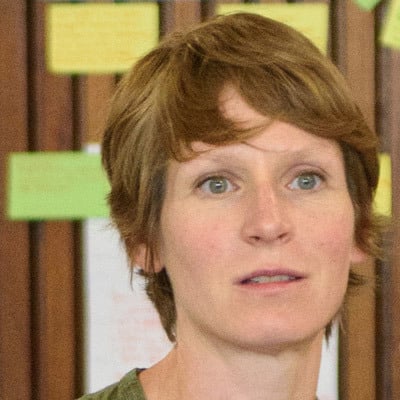
Laura Winn is head of the School of System Change at Forum for the Future. She works to develop the School as a networked organisation that supports change-makers from diverse backgrounds and contexts, providing them with new capabilities to tackle an increasingly complex set of sustainability challenges. Laura's own practice stems from living systems and regenerative approaches, learnt and applied across multiple small-scale and large-scale projects.
originally published at School of Systems Change

Network Weaver is dedicated to offering free content to all – in support of equity, justice and transformation for all.
We appreciate your support!
donate in the box above or click here
Network Weaving for Equitable Wellbeing
December 6, 2022Blog,Equityequity,Systems Change,Wellbeing
The following post was written for those who will be attending the Full Frame Initiative's (FFI) Wellbeing Summit in Charlotte, North Carolina December 11-14. The Interaction Institute for Social Change has been supporting FFI staff and signers of the Wellbeing Blueprint in developing network ways of thinking and doing as they work to ensure equitable wellbeing in systems ranging from health care to transportation to housing to education to legal aid to food and beyond. Feel free to sign the Wellbeing Blueprint by going to the link above and join the movement to make sure everyone has a fair shot at wellbeing!
"It really boils down to this: all life is interrelated. We are all caught in an inescapable network of mutuality, tied into a single garment of destiny. Whatever affects one directly, affects all indirectly.”
- Rev. Dr. Martin Luther King Jr. (minister, activist, civil rights leader)
What are networks, and why should we care?
Networks are collections of “nodes and links,” different elements that are connected to each other. These nodes or elements could be people, places, computer or airport terminals, species in an ecosystem, etc. Together, through their connections, these nodes create something that they could not create on their own. This is what some might call “collective impact” or what network scientists call “net gains” and “network effects.”
“While a network, like a group, is a collection of people, it includes something more: a specific set of connections between people in the group. These ties are often more important than the individual people themselves. They allow groups to do things that a disconnected collection of individuals cannot.”
- Nicholas A. Christakis (sociologist, physician, researcher)
Network effects and net gains can include the following:

- Resilience - The ability for a network to weather storms of different kinds, literal and metaphorical, and to bounce back from adversity. Healthy networks can bend without breaking.
- Adaptation - The ability for a collective to change with changing conditions. Healthy networks can rearrange themselves to adjust and respond to disruptions and perturbations.
- Small World Reach - The ability to reach others relatively quickly, across different lines of separation or difference (geography, culture, sector, etc.) . Healthy networks have a diversity and intricacy of pathways, so there are a variety of ways to reach many different nodes/members efficiently.
- Rapid Dissemination - Related to reach, this is about the ability to get crucial resources out to a wide variety of nodes in a timely manner. Healthy networks can ensure that different members can get the nourishment (information, ideas, money, food, etc.) they need to survive and thrive. (1)
“Connections create value. The social era will reward those organizations that realize they don’t create value all by themselves. If the industrial era was about building things, the social era is about connecting things, people, ideas."
-Nilofer Merchant (entrepreneur, business strategist, author)
Other “network benefits” can accrue to individual nodes or members of a network. For example, when surveying members of different kinds of social change and learning networks, some of what often gets mentioned as benefits include:
- Being with other people who inspire and support me
- Learning about topics relevant to my work
- Understanding the bigger picture that shapes and influences my work
- Gaining new tools, skills and tactics to support my work
- Having my voice and efforts amplified
- Accessing new funding and other resources
- Forming new partnerships and joint ventures
What is a healthy network?
“We are the living conduit to all life. When we contemplate the vastness of the interwoven network that we are tied to, our individual threads of life seem far less fragile.”
– Sherri Mitchell/Weh’na Ha’mu’ Kwasset (Penobscot lawyer, activist, author)
A healthy network is one that is able to achieve its collective purpose/core functions, while also addressing the interests of its members, and continuing to be adaptive to changing circumstances. Some key features of these kinds of networks include (2):
- Diversity of membership
- Intricacy of connections (many pathways between nodes)
- Common sense of purpose or mutuality; a sense of a “bigger we”
- Robustness of flows of a variety of resources to all parts of the network
- Shared responsibility for tending to the health and activity of the network
- Resilient and distributed structure(s) with a variety of shared stewardship roles
- A sense of equitable belonging and ability to give to/benefit from the network
- Ongoing learning and adaptation
Like any kind of living organism, networks require care and feeding to keep them vibrant. This is where network weaving comes into play!
What is network weaving?
“A network weaver is someone who is aware of the networks around them and works to make them healthier.”
- June Holley (writer, activist, network consultant)
Network weaving is an umbrella term for the practice of network leadership/stewardship, and it refers to a specific role. If you think about weaving with fabric, it is about bringing different strands together to create a tapestry or cloth of some kind. This can create beautiful patterns, functional garments, and also strength where individual fibers might otherwise be relatively weak. The same goes for weaving connections between people, places and ideas. This is what network weaving is about!
Network weaving is not necessarily the same thing as networking. Networking is generally about putting oneself at the center and making connections to others that create what is called a hub-and-spoke network (see middle image below).
“We never know how our small activities will affect others through the invisible fabric of our connectedness. In this exquisitely connected world, it’s never a question of ‘critical mass.” It’s always about critical connections.”
- Grace Lee Boggs (author, social activist, philosopher)
A core activity in network weaving is what is called “closing triangles.” (3) This happens, for example, when we connect people we know who do not already know each other. This effectively creates a triangle of connection (see the many triangles created through the connections in the left hand image above). These triangles, by extension, can bring the connections that those three people know together, potentially creating more diversity, intricacy and robustness in a larger network (see image below). This is how we can begin to realize a sense of abundance, if these many connections are actively engaged, sharing, contributing and caring for each other and the whole network.
The work of network weaving is also about strengthening existing connections, keeping them warm and engaged. This can happen through asking questions, making requests and offers, and sharing resources of different kinds. Beyond this core function of supporting greater connectivity, network weaving can also be about supporting greater alignment and coordinated or emergent/self-organized action in networks. Other key activities for weaving and activating networks include: designing and facilitating processes to achieve a sense of shared identity/destiny, creating conditions for self-organized and emergent action, curating resources, creating diverse communication pathways, and helping to coordinate joint ventures.
What do networks and network weaving have to do with a fair shot at wellbeing?
“Connectedness is a social determinant of health. The degree to which we have and perceive a sufficient number and diversity of relationships that allow us to give and receive information, emotional support and material aid; create a sense of belonging and value; and foster growth.”
- Katya Fels Smyth (wellbeing/justice advocate, Full Frame Initiative founder)
Wellbeing, as defined by the Full Frame Initiative (FFI), is “the set of needs and experiences that are universally required in combination and balance to weather challenges and have health and hope.” FFI notes further that everyone is wired for wellbeing, but we do not all have a fair shot at the core determinants of wellbeing, or what FFI uplifts as the 5 Domains of Wellbeing. (4)
- Social connectedness to people/communities that allows us to give and to receive, and spaces where we experience belonging to something bigger than ourselves.
- Stability that comes from having things we can count on to be the same from day to day and knowing that a small bump won’t set off a domino-effect of crises.
- Safety, the ability to be ourselves without significant danger or harm.
- Mastery, that comes from being able to influence other people and what happens to us, having a sense of purpose and skills to navigate and negotiate our life.
- Meaningful access to relevant resources like food, housing, clothing, sleep and more, without shame, danger or difficulty.
The first domain above has clear connections to networks and network weaving. Being embedded and engaged in supportive social networks is a great contributor to individual and collective wellbeing! Beyond this, being connected to others in authentic, caring and mutually rewarding webs of relationships can contribute to a sense of stability, safety, purpose, as well create access to resources (financial and otherwise) that sustain and enliven us. So let’s notice the networks around us, who is in them and who is not, who has access to the five domains and who does not, and invite others to do the same. Ask, ‘What systemic/structural changes need to be made for greater inclusion, equity and belonging?” And then together, let’s weave our way to everyone having a fair shot at wellbeingll!

“i think of movements as intentional worlds … not as an unfolding accident of random occurrences, but rather as a massive weaving of intention. you can be tossed about, you can follow someone else’s pattern, or you can intentionally begin to weave and shape existence.”
- adrienne maree brown (author, doula, activist)
For more on network weaving, see:
- 25 Behavior That Support Strong Network Culture
- 3 Mantras and 3 Small Moves for Advancing Networks
- Network Bridging: How a Regional Network is Creating New Connections, Flows and Opportunities
1. See NET GAINS: A Handbook for Network Builders Seeking Social Change https://www.researchgate.net/publication/238708418_NET_GAINS_A_Handbook_for_Network_Builders_Seeking_Social_Change
2. More on the health of networks can be found here, in the work of Dr. Sally J. Goerner - https://capitalinstitute.org/wp-content/uploads/2014/08/000-Goerner-Regenerative-Development-Sept-15-2015.pdf
3. See more about network weaving and closing triangles at http://www.thenetworkthinkers.com/2009/11/network-weaving-101.htm
4. https://fullframeinitiative.org/wp-content/uploads/2020/12/Five-Domains-of-Wellbeing-Overview.pdf

About the Author:
Much of Curtis Ogden's work with IISC entails consulting with multi-stakeholder networks to strengthen and transform food public health, education, and economic development systems at local, state, regional, and national levels. He has worked with networks to launch and evolve through various stages of development.
Originally published at Interaction Institute for Social Change on Nov 29th & Dec 6th
featured image found HERE

Network Weaver is dedicated to offering free content to all – in support of equity, justice and transformation for all.
We appreciate your support!
donate in the box above or click here
Stories that Change Systems
November 29, 2022Blog,Systems ChangeSystems Change
This blog was originally published in February 2022 by Rotary Charities of Traverse City.
“Stories make, prop up, and bring down systems. Stories shape how we understand the world, our place in it, and our ability to change it.”
– Ella Saltmarshe, Telling the Difference
In November of 2021, Rotary Charities began piloting a new service for collaborative initiatives working to solve complex community problems, systems change coaching. Coaches with varying expertise - from convening and facilitation, systems mapping, shared governance and decision making, and collaborative fundraising - have been made available to fifteen different initiatives that are taking a systemic approach to address a community issue.
Three months into the eight-month pilot, we have noticed a pattern. Nearly 70% of requests have been for guidance related to communications or storytelling. This piece explores the unique power of story in systems change work and shares some local examples of how initiatives are using story, as well as how and why initiatives remain challenged to use this tool to its full potential.
The demand for storytelling support was surprising on the surface, but after some reflection, it became obvious how vital storytelling is to the success of initiatives that are aiming for large-scale transformation. Storytelling has tremendous worth both internally to build coherence and purpose across diverse actors in a system, as well as strategically to build public understanding, empathy, and belief in the possibility of a different future.
Ella Saltmarshe in her piece, Telling the Difference: Using Story to Change Systems, frames this as the power of story to light (illuminate), glue (cohere), and web (shape mindsets).
Illuminate
Stories help us describe the current state of a problem, the systemic factors creating the problem, what needs to change, and can help us see our role in both the problem and the solution. We can use stories to amplify the voices of those with lived experience with an issue, helping us to build understanding and empathy for perspectives and experiences different from our own.
The Public Will Campaign to End Child Sexual Abuse, a partnership between the Traverse Bay Children’s Advocacy Center and Michigan State University, and one of the first Rotary Charities systems change grantees, sees story as central to their work. Early on, the Campaign’s core team designed a Storytelling Workshop and Our Stories website page for sharing common landmarks around the issue of child sexual abuse to help influence normative behavior. The Campaign also curated literature and media on their website to further illuminate the subject. They have recently been awarded a Rotary Charities Seed Grant to partner with University College Dublin to facilitate book clubs in the region and measure changes in participant awareness, empathy, and willingness to act to protect children. “Despite the prevalence of child sexual abuse, it remains a relatively taboo subject due to its intensely upsetting nature,” notes the Campaign’s former Executive Director, Sue Bolde. “Stories help to ease our ‘social flinch’ from engaging with the issue, which positively affects efforts to prevent CSA and to support survivors.”
Another systems change grantee, The Northern Michigan Community Health Innovation Region (CHIR) has recently launched an intensive focus on behavioral health and wellbeing and are using a different type of storytelling device, photographs. The CHIR was awarded a Seed Grant to recruit high school youth to take photographs that depict their perspectives and experiences with mental health and wellness, a strategy called PhotoVoice. The photos will be debuted to hundreds of practitioners and community members at an upcoming Behavioral Health Summit in April, and then will form a traveling exhibit.
Cohere
Transformative change work requires the participation of many people from different parts of a system, often with differing perspectives and experiences. Stories can facilitate the work of convening and connecting people to a shared purpose and each other. Many networks, like the newly formed Sonder, begin meetings with small group connection activities, allowing space for participants’ own stories to emerge, revealing their personal motivations, connection to the work, and place in the system. This type of sharing is more than an ice breaker. As MIT professor Otto Scharmer puts it, it can help the “system sense and see itself,” and allows a group identity and shared understanding to grow over time.
The Northwest Michigan Arts & Culture Network began collecting stories from its members about what they valued about participating in the network, and are now working with a consultant to broaden input from all network stakeholders. The stories are shared internally to help members understand what they are making possible for each other and with the broader communities to build cross sector engagement. They will also begin work with a systems coach to chisel its messaging to better tell its story to all. The network's first work in public will building grew from Arts Midwest's Creating Connection training, resources and findings from national research around public values, behaviors, and attitudes as they relate to arts and culture. Creating Connection is part of a broader effort to use social change strategy to build public will to make arts and culture a more recognized, valued, and expected part of everyday lives.
The Public Will Campaign has taken the additional step of making their personal stories and connections to the work of preventing child sexual assault visible to the public on their website. In this way, the community can also more deeply connect to the people and motivation behind the Campaign and perhaps be inspired to join the effort.
Shape Mindsets
Without even realizing it, we live in a “nest of narratives” that shape how we believe the world works, what is tolerable, and what is possible. Saltmarshe asserts, “If we want to change specific systems, we first need to make mirrors that enable us to see the narratives we currently live by, and then author new narratives that enable the kind of change we want to see in the world.”
Stories can help us see and long for an alternative future, and help us imagine a role for ourselves in building that future.
This power of story, often called Narrative Change, is perhaps its most potent in social change work. As narrative change consultants, Frameworks Institute, shared in a recent report and webinar series, transformative change often requires policy change. Policy does not often shift or endure without significant shifts in public opinion. And public opinion does not change without shifting the popular narrative.
One example that is often cited is the shift in strategy of the Freedom to Marry campaign. When the movement shifted from an equal rights and benefits framing to a frame focused on love, commitment, and freedom, “love is love,” the country saw one of the most rapid swings in public opinion, marriage equality legislation passing in many states, and the landmark 2015 Supreme Court ruling.
Supporting Storytelling
Even with storytelling such an influential practice in social change work, it remains sorely under-supported and under-resourced, and thus can be very challenging. Systems coach Jessica Conrad has been focusing her time in the pilot on communications and storytelling and shares, “We need to help people—especially those in a position to support this work—see the tremendous value of storytelling as a systems change strategy. How to create and share more impactful stories of change is a field-level challenge, and solving it will require an investment in our collective creativity and imagination." Initiatives are reaching out to the pool for assistance with:
- Bridging systems change work with the human stories of those who will ultimately benefit: The focus of systems change work is typically on the structures, practices, and mindsets that influence how a system behaves and this can feel very removed from the ultimate purpose of the work – to make systems work better for all. Coaches have been helping initiatives uncover and illuminate how their work will ultimately help real people through exercises like Nine Whys and Empathy Mapping.
- Holding space for initiative participants to share their own stories: Personal storytelling requires trust and vulnerability, which can take time and care to develop. Coaches are helping initiatives with ideas of how to add connection activities into meeting agendas that ease participants into getting to know one another, and make more visible what holds them all together.
- Developing a common narrative: It can be difficult to talk about systems change work because it is complex, is not business as usual, and often involves the work of many different players. Coaches are working on helping several initiatives to develop a Common Narrative to serve as the frame that all other stories can hang on. A common narrative can allow diverse storytelling to emerge from across a system, and still harken back to the shared purpose of the work for the audience (a sort of hash-tag effect).
Storytelling alone will not change entrenched systems, but it is a powerful tool worthy of greater intention and investment. We look forward to learning and sharing more about how coaching may help initiatives tell stories that illuminate, cohere, and shape mindsets.
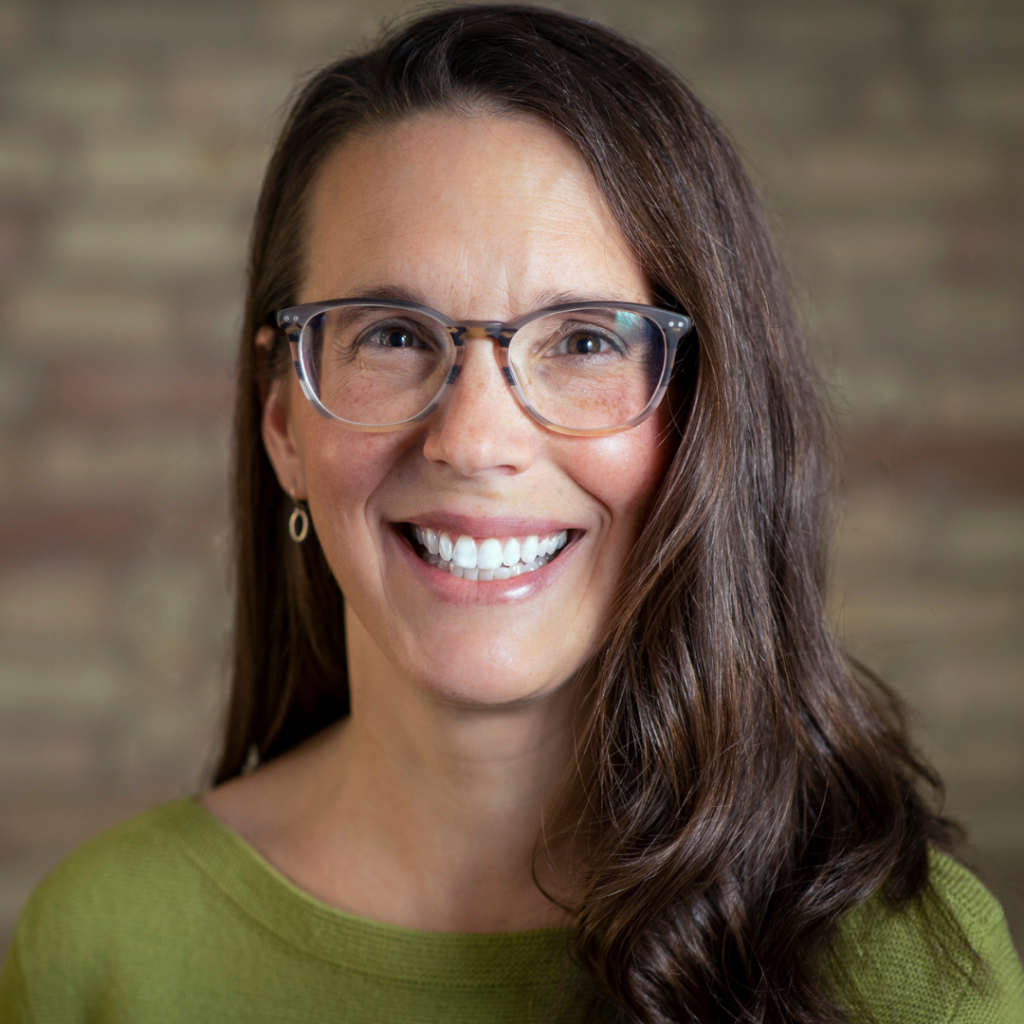
Freya Bradford is the Director of Systems Change and Learning at Rotary Charities of Traverse City. You can reach her at fbradford@rotarycharities.org
Originally publlshed at Rotary Charities
Photo by Alberto Biondi on Unsplash

Network Weaver is dedicated to offering free content to all – in support of equity, justice and transformation for all.
We appreciate your support!
donate in the box above or click here
Peer Learning Changes Everything — but How to Make it Work?
November 15, 2022Network Support Structures,Blog
Increasingly in networks and communities I’m part of, the activity participants see the most value and impact in — and engage with regularity and enthusiasm — is peer learning circles.
I have found that peer learning circles are fantastic at:
- Helping people get direct answers to challenges they face and reducing repeated mistakes across projects and organizations
- Introducing people to new and diverse perspectives that can foster creative ideas and spark mindset shifts
- Providing a safe space to raise important but tough issues people might not otherwise share
- Fostering new and deep relationships, which can (and usually do) form the basis for longer-term collaboration
- Creating a sense of support, solidarity and collective power, like “we’re not in this alone” (this is not to be undermined!)
They also, when done well, can expose participants to new leadership skills and mindsets, help a community realize it only need look inward for answers, and sustain connection and engagement over the long-term.
And they function beautifully in organizations, communities, schools, movements, networks, etc.
* * *
A quick clarification: I’m not talking about working groups, workshops, webinars, or meet-ups. These are, I think, great for building awareness, connecting to the bigger picture, and communicating to a group.
But what they don’t facilitate is deep, meaningful changes in the way we think or work over the long-term.
When I say peer learning circles, I mean small groups of people who regularly and consistently meet to connect and exchange. Sometimes these are also called “clusters” or “communities of practice”.
* * *
So many times though, I’ve seen learning circles fall short of achieving what they set out to achieve…
Often, we set them up and then let them “go free” — expecting them to continue on their own.
But what happens instead is, after an initial spike of energy and interest, things start to fall through. Some people don’t show up. Meetings get cancelled last minute. Energy dwindles. Then, silence.
And once that happens, they are very hard to re-create and re-invigorate.
Over the past year I’ve been trying to determine the right “formula” to help such groups thrive. So that groups meet regularly, and participants feel high value in them and a desire to engage. While at the same time, the burden of coordination and facilitation is light enough that they can scale with ease.
There’s a lot of tiny pieces that, when they all come together, allow for many learning circles to thrive. Here’s what I’ve come up with so far:
- Outline a clear and simple purpose. Make sure participants know exactly what the circles are trying to achieve. As an example, I often say: to get advice from peers for questions you face, while building deep relationships.
- Establish — and repeatedly emphasize — shared principles. Create a brief list of “community guidelines” that foster safe and trusting spaces, like everyone has a voice / we valorize diversity / what’s said here is confidential. Make sure they are written in calendar invites, and repeatedly shared at the beginning of meetings.
- Introduce a straightforward process. Make it super easy to self-facilitate, with only a few steps that are achievable in a short time frame. My go-to processes: peer assist, troika consulting, case clinic (I’ve also been recommended, but haven’t yet used, Working Out Loud). Leave only some room for flexibility — I usually recommend adding a) personal updates, b) round-robin sharing of exciting news, and c) a closing question like “how will you take what you’ve learned today to your work / life?”
- Clarify commitment. This makes all the difference. Draw out time requirements for meetings (e.g. 60 minutes monthly) and if anything’s expected beyond (e.g. one group I know agreed to “never leave with a to-do list”). And facilitate it so participants confirm their commitment to each other (not just to you as the coordinator) in a meeting or group message/email— this fosters peer accountability, which is a powerful force.
- Agree on an end date. Like, 6 months. This clarifies that the circles won’t last indefinitely, and helps people decide if they want to engage now, or later. After the end date, switch people around. Form new clusters and relationships. Let knew people join, and give current participants the option to opt-out.
- Matchmake groups. Sometimes letting people self-select is useful, but often the back-end work of weaving — finding synergies and fostering new connections — is more powerful. Create groups of people that don’t know each other but can complement each other in some way, e.g. location, area of interest, common needs, position in the organization. There is no perfect formula; sometimes “I just think these people would really hit it off” is enough!
- An optimal size is 6–8 people per group. Smaller groups risks that if 1 or 2 can’t show up, meetings get cancelled. Larger groups reduces participants’ time to speak as well as the sense of cohesion and relationships.
- Appoint, and consistently support, a group “lead”. Ask people to self-nominate, or select someone who is motivated and willing to input the extra time. Clarify their role: to make sure the purpose, process, commitments, and principles are adhered to — and those joining get value from participating. And regularly connect with these leaders, in 1:1’s and in small groups, so they can also learn and troubleshoot together.
- Do the scheduling yourself. I’ve seen this too often: groups fall through for one simple reason, the scheduling gets too complicated. So take that off their hands! That way, they can focus on what matters: the dialogue and the relationships. Practically this means helping each group find a recurring time (use Doodle), then set up a recurring invite on a common community calendar. If it’s online, see if they need a video conferencing tool.
- Give nudges to help build habits. Sometimes, people just need a small nudge or reminder to show up (especially if they are not strict calendar users). One trick I’ve used: I set an auto-reminder on the common calendar to send a template message a few days before each cluster meeting saying essentially: “please remember to RSVP — it’s of respect to your group lead who is volunteering their time.” Another trick: inside the calendar invite, I put the purpose, principles, commitment, and link to the structure — so it is ever-present. Remember these groups are usually “external” to participants’ everyday lives, and they will usually appreciate it if you help them internalize it.
- Finally, connect to a larger purpose. Small groups are lovely, but sometimes participants can say “we don’t see how we’re part of the bigger picture.” Find ways to integrate what they’re learning with the larger network’s activities, like inviting groups 1-by-1 to share-out what they’re learning in open events.
Two other things I’ve learned the hard way: don’t over-expect, and don’t rush it. Relationship and trust-building takes time, and people also need to understand what others can offer. Asking a group to do too much (e.g. co-create an “outcome”) too early can quickly lead to drop-off.
Anything else you’ve found helpful?

Brendon Johnson is a seasoned changemaker with a passion for strategies and models around networks, communities, participatory organizing, and collaborative action
Originally published at Medium
Photo by Jose Aljovin

Network Weaver is dedicated to offering free content to all – in support of equity, justice and transformation for all.
We appreciate your support!
donate in the box above or click here
6 Reasons Why Liberatory Leaders Need to Take Play Seriously
November 7, 2022Liberating Structues,Systems Change,Liberatory Networks,Collaboration,Liberatory,Systems ChangeNetwork Support Structures,Play,Transformation,Blog,Transformation,Dismantle Racism
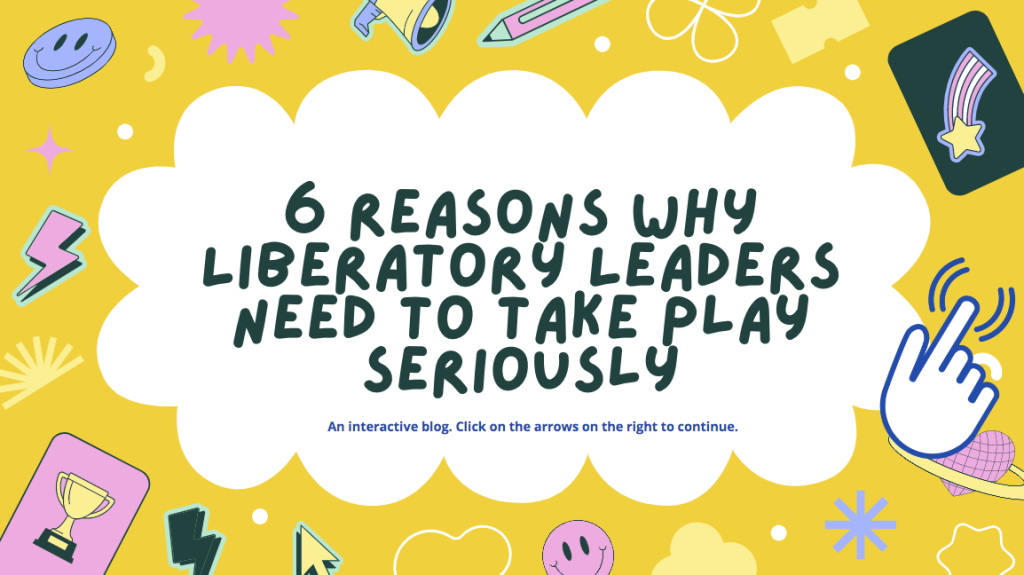
When was the last time you played, did something just because it was fun and felt good? Did you finish feeling enlivened, relaxed, energized, or something similar? Leadership Learning Community has been exploring the roles of fun and play in our activities. This exploration didn’t start out super intentional, but rather as a reaction to the pandopalypse we’ve all been living in. Over time LLC began discussing play in relation to our work, referring to aspects of our work as “playful” or describing meetings and convenings as “play spaces.” For us, this isn’t a cutesy communications strategy. As LLC began to turn our attention to play, we realized that play, when grounded in collective purpose and steeped in values, can be a liberatory act.
Here are six reasons why we believe play can help leaders embrace liberatory practice.
Fuel Ideation
- Play can be described as “something that’s imaginative, self-directed, intrinsically motivated and guided by rules that leave room for creativity.” By creating space for creativity and imagination, play helps to quiet the self-conscious, judgemental inner critic. This voice discourages deviations from the known norm and makes trying on new things feel too risky. Without that voice, perhaps there is room for a little bit of magic to invite in new possibilities. Taking a playful stance allows us to adopt a child-like or beginner's mind, and helps us to develop mental plasticity and adaptability while simultaneously reminding us that our options aren’t all pre-determined and that there is space for the not yet known. This opening of possibility is critical as liberatory transformative efforts are dreaming and imagining into being something that does not currently exist. To do that, we have to stretch our imagination muscles.
- Practice: Start the meeting with a playful check-in question like, “If you could go back in time (or to the future), who would you want to meet?” or pick a favorite zoom filter to start the meeting with. Check out more of our check-in questions here.
Nurture, Healing & Wellness
- Play is an effective way to manage stress and can be a tool of both self and collective care. Play helps us to be in the moment, similar to meditation. In contrast to oppressive practices, which are confining and restrictive, sapping our spiritual and figurative energy; the enlivening nature of playful activities may help to heal these wounds.
- Practice: Host meetings near a park, the ocean, or in nature. Take a walk. Find new analogies for the work we do.
Create New Models of Strategic Thinking
- Playing makes things real, during play we don’t just imitate we also imagine and embody (something). Trying on liberation in play spaces/playful ways allows us to feel the benefit of liberation in the moment while we are learning more than we currently know. This focus on liberation now means that during play liberation doesn’t just have to be a future goal. In addition, some studies suggest that play supports memory and thinking skills, so play may literally help us think our way to freedom.
- Practice: Do some creative writing. Some of us have and are taking a writing course with Dara Joyce Lurie. She shares a quote from Edward de Bono, “Rightness is what matters in vertical thinking. Richness is what matters in lateral thinking. Vertical thinking selects a pathway by excluding other pathways. Lateral thinking does not select but seeks to open up other pathways. With lateral thinking one generates as many alternative approaches as one can. With vertical thinking one is trying to select the best approach, but with lateral thinking one is generating different approaches for the sake of generating them.”
Expand Leadership Opportunities
- Because play utilizes “creative rules” that are distinct from the rules and restrictions of regular life, in play, there exists the opportunity, though not the requirement, to separate capacity from expertise. All of a sudden, players “can” do things even if they aren’t experts at said activity. So you can play at being a pilot without actually knowing how to fly a plane. In playful spaces more people can function as leaders, meaning more people can be actively involved in imagining liberatory practice into being.
- Practice: Acting and improvisation exercises like “Questions Only” where you act out a scene given to you with only questions.
Build Community:
- Play offers us the opportunity to connect. When we create safe play spaces there is little risk to engaging. People can show up with a less performative stance. BIPOC leaders frequently find themselves under a spotlight or a microscope. The labor of being forced to code-switch or deal with being othered is exhausting so I imagine that BIPOC leaders especially are eager for safe spaces to be themselves. Where showing up as one’s whole self is an invitation and a demand, and for the purpose of supporting the BIPOC leader not to be of utility to others. Often BIPOC leaders are told to show up as their full self because observing BIPOC leaders is good for an observer, not for the benefit of the BIPOC leader.
- Practice: Shorten the strategic side of the meeting, and incorporate the karaoke, fun, and games as part of the meeting, not just extra at the end.
An Invitation to Wholeness:
- By allowing us to focus on pleasure and fun rather than objectives and outputs, play encourages us to be more than what we can produce. Perhaps play is akin to rest in that way, and maybe we can view embracing the revolutionary possibility of play in the same way that we have begun to respect how rest can be resistance. This need for play spaces may prove to be especially important for BIPOC leaders given that kids of color are often adultified early, and deprived of the space to play freely. By recapturing play, as we have attempted to reclaim rest, we may enliven our work and find new paths toward liberation.
- Practice: Make space for play at every meeting whether it’s a check-in, the location, the activities, or the bonding event. Make play and joy part of your community agreements so they show up intentionally during your work.

Ericka Stallings is the Co-Executive Director of the Leadership Learning Community (LLC) a learning network of people who run, fund and study leadership development. LLC challenges traditional thinking about leadership and supports the development of models that are more inclusive, networked and collective. Prior to LLC, Ericka was the Deputy Director for Capacity Building and Strategic Initiatives at the Association for Neighborhood and Housing Development (ANHD), supporting organizing and advocacy and leading ANHD’s community organizing capacity building work.

Nikki Dinh is the daughter of boat people refugees who instilled in her the importance of being in community. Though she grew up in a California county that was founded by the KKK, her family’s home was in an immigrant enclave. Her neighborhood taught her about resistance, resilience, joy and love.
originally published at Leadership Learning Community
Network Weaver is dedicated to offering free content to all – in support of equity, justice and transformation for all.
We appreciate your support!
donate in the box above or click here
by Ericka Stallings and Nikki Dinh, co-executive directors of Leadership Learning Community
Alexis Goggans
Alexis Goggans, PCC is an equitable decarbonization and organizational development consultant, a trusted instructor, and an accredited life, leadership, and executive coach. She's the mind behind Be Bold Services, a small consulting firm that has been helping individuals and organizations implement climate, sustainability, and social change initiatives rooted in deep equity since 2018. Alexis is also co-founder of the Institute for Coaching Excellence, an online training program that provides aspiring professionals with a certificate in Life, Leadership, and Executive Coaching.
